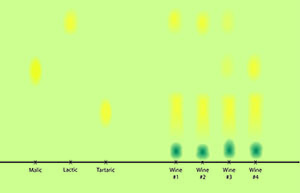
Before you set about making any major changes to this wine, make sure that when you taste you are not tasting a sample that has a lot of dissolved carbon dioxide gas in it. Tiny bubbles can be refreshing in a white or pink wine, but they can contribute to a sense of sharpness and a perception of increased acidity, essentially because dissolved carbon dioxide gas (+ water=carbonic acid) will actually decrease the pH of the wine. To de-gas a tasting sample, simply seal up about 100 mLs in a small jar or bottle and shake vigorously, then release the seal on the container, “burping” your wine of its dissolved gas. Repeat two or three times or until the wine isn’t foaming so much anymore. Then pour into a glass and swirl, sip and spit.
Also, try tasting at a higher temperature. Anything below 45 °F (7 °C) can increase the perception of acidity.
You are doing a lot of things right to get that bright fruit to show through, namely racking, cleaning the wine up with bentonite and cold stabilizing it. Looking at your numbers though, I am thinking that your pH is a probably a little “bitey” (as my New Zealand winemaking friends might say).
Your FSO2 is also a little bit too high — at a pH of 3.16, your added sulfites will be very effective (more in the molecular and antimicrobial form) and so you could probably get away with bottling at FSO2 of 25 ppm even. Too much SO2 can actually give your wine a burning sensation on the nose and can really deaden the fruit. In red wines, too much SO2 at bottling can actually bleach color.
Adding a little bit of toasty, vanilla-y oak might help your wine taste a little bit more like Chardonnay and would be an easy addition to do. If you can, do small bench trials first (soak an oak chip in a baby food jar full of your wine for example) to see if you like the treatment before you subject your whole batch of wine to it. As always with oak (and most additives), start conservatively because you can always add oak, and it’s almost impossible to remove.
Taking your wine through MLF at this point would be near impossible because you’ve got two major counter-indications, namely your low pH (bacteria thrive only at high pHs) and your high sulfite level (no ML bug will survive at that level). To get MLF to push through, you’d have to take down the acidity with calcium carbonate and try to “age out” the sulfites (FSO2 will eventually disappear with time, though your total will remain the same) or add hydrogen peroxide to the wine to bind up the sulfites. In my experience, these are two pretty extreme “interventionist” steps that would really mess with the aromatics and the mouthfeel.
So what to do? I think your two best bets are these: 1) blending and/or 2) residual sugar adjustment. If you have a white wine (or can make one) with a higher pH that you can blend with this bitey little number, the end result wine might be something you’d be proud of. If you don’t happen to have a handy 7-gallon (26-L) batch of mL-complete Chardonnay on hand, an easier tweak (note I’m not saying “fix”) is to trick your taste buds to enjoy the wine a little more and counterbalance some of that acidity with a little residual sugar (RS). Sweetness will directly counteract the high acidity on your taste buds and will probably improve the mouthfeel by increasing the sensation of roundness in the wine. For an acid level this low, I’m thinking you might want to add 0.30–0.50%, depending on how sweet (or not) you like your wines. You can use grape-juice concentrate (buy through a home winemaking supply source, don’t get Welch’s from the store), table sugar or even honey to sweeten, whatever you desire.
Anytime there’s over about 0.20% residual sugar in a wine (and especially if the pH is higher, which encourages microbial growth too) you run the risk of ambient microbes eating that sugar and turning it into carbon dioxide and making your wine fizzy and cloudy. Though because your pH is so low and FSO2 is so high your re-fermentation risk is lowered, I still think it’s a good idea to be careful. If you decide to go this route, do bench trials to figure out how much sugar tastes good and be sure you sterile filter (0.45 nominal pore size) before you bottle.





